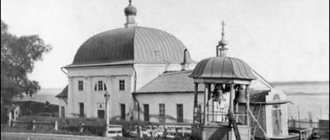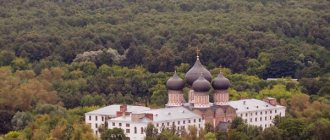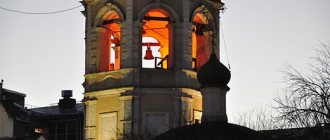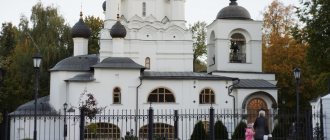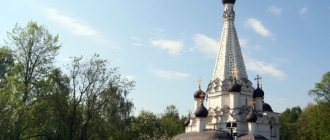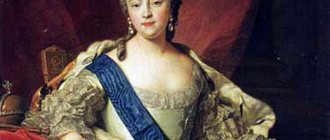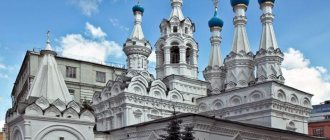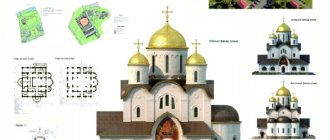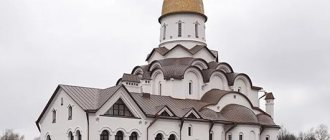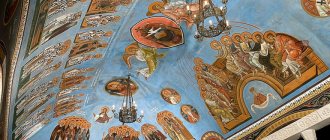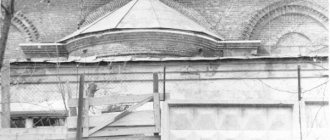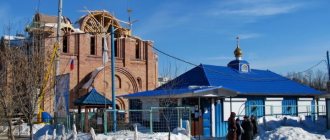Share
Church of the Assumption of the Blessed Virgin Mary in Putinki. Photo: NVO
Address of the Church of the Assumption of the Mother of God in Putinki: Uspensky lane, 4
The Church of the Assumption of the Mother of God was first mentioned as wooden in documents of 1625. It was located on the land of the Novgorod hundred. By the way, a hundred, along with, say, a settlement, is a territorial unit, a settlement that unites “blacks,” that is, ordinary working people, within a certain limited territory. Later, the territorial units disappeared, and therefore the word “hundred” for us is more likely a kind of Cossack unit consisting of a hundred people. Well, this is by the way...
The stone church was built half a century later. At the same time, the refectory was erected, and a quarter of a century later, the Chapel of St. Nicholas the Wonderworker was also mentioned. The bell tower was erected much later, in the second half of the 18th century. There were 6 bells in total, but 5 of them appeared on the bell tower in the 19th century.
The lane on which it stands is named after the Assumption Church - its exact address is Uspensky Lane, 4. But according to Moscow custom, the church also has a clarification - its full name is the Church of the Dormition of the Mother of God in Putinki.
The outlying settlement of Putinki was located behind the Tverskaya Gate of the White City (now it is Pushkinskaya Square and Strastnoy Boulevard). Once upon a time, the suburban "Great Meadows" stretched here, and two wide roads began here - to Tver and Dmitrov. It is believed that here in the 16th century there was a country palace of Vasily III, which later became the Travel Palace, where foreign ambassadors stayed. And the name “Putinki” most likely comes from the word “path”. We drove into the Travel Palace along Putin routes - crooked streets and alleys.
All the years of its existence, the temple was famous for its myrrh-streaming icon of the Assumption of the Virgin Mary. In 1922 the temple was closed. And it would have been fine if it had simply been closed, but five domes and the top of the bell tower were broken, the apses were destroyed, and windows and a door were broken in their place.
During the Soviet period, the territory of church property was significantly reduced. On part of its territory, the building of the Embassy of the People's Republic of Benin was built. By the beginning of the 1990s, not a single historical structure remained on the territory of the temple, except for the building of the temple itself.
Since the transfer of the temple to the church in 1992, restoration of the temple was carried out, which was eventually successfully completed. And the temple now regularly receives parishioners. And one last detail - several ancient icons were presented to the Assumption Church by the famous rock musician, leader of the Aquarium group, Boris Grebenshchikov.
How to get there by public transport
The Church of the Assumption of the Blessed Virgin Mary in Putinki is within walking distance from the following metro stations:
- Pushkinskaya (lilac branch);
- Chekhovskaya (gray line);
- Tverskaya (green line).
From the Pushkinskaya metro station you need to turn left and walk to Malaya Dmitrovka. At the crossing, go to the opposite side of the street and turn left. Having reached the intersection of the street with Uspensky Lane, they turn right and after 100 meters a small white church building appears in front of the pilgrim.
History of the temple
The first mention of an area called Putinki dates back to the 14th century. Here, behind the Tver Gate of the White City, the roads leading to Tver and Dmitrov began. 200 years later, Grand Duke Vasily III built a palace in a Moscow suburb. After some time, it became a travel palace, which was used for the needs of the embassy.
The Church of the Assumption of the Blessed Virgin Mary in Putinki was built according to the design of an architect whose name is no longer known today
The road to it went along narrow winding streets called Putinka. Researchers believe they gave the area its name.
The Church of the Assumption of the Blessed Virgin Mary in Putinki was originally a wooden structure, which often suffered from fires. Probably, after one of the fires, the damaged building was dismantled. The stone temple was consecrated in 1679. The construction of the main volume of the temple and its refectory part dates back to this time.
Ten years later, the Nikolsky chapel was added to the northern façade. The ensemble of the temple was finally formed in the 2nd half of the 18th century. when the bell tower was added. At this time, residential buildings for clergy and a malthouse were built.
By the end of the 19th century. The interior of the temple needed restoration, which was carried out with the generous donation of an unknown person.
During the restoration process the following work was carried out:
- gilding of the iconostasis;
- icon update;
- painting of walls and vaults.
After the Bolsheviks came to power, the Church of the Assumption of the Blessed Virgin Mary, located in Putinki, shared the sad fate of many sacred buildings. In 1922, under the pretext of helping the starving regions of the country, the Assumption Church was looted. In the same year, services here ceased.
The religious building was subjected to desecration, which consisted of the following:
- demolition of five chapters of the main volume;
- removal of the dome and belfry from the bell tower;
- demolition of apses and installation of new entrances and windows.
For 50 years, the building housed a residential building. In the 70s XX century The residents of the dilapidated building were resettled, and the building began to be used for economic purposes. At first, the workshops of the All-Union House of Models were located here, and then the production of medicines.
The church territory shrank significantly during the years of Soviet power. An administrative building was built in the western part of the site, which today houses the diplomatic mission of the state of Benin. The revival of spiritual life in the building of the Assumption Church began in the early 90s.
In 1992, with the blessing of His Holiness Patriarch Alexy II, Archpriest Gleb Afanasyev became rector of the parish of the Assumption Church. Thanks to the efforts of this already elderly and frail man, the walls and vaults of the church building were restored within 3 years. In June 1995, the earthly island ended. Gleba.
40 days after his death, the temple was decorated with new chapters and crosses. The external restoration ended there, but labor-intensive and painstaking work lay ahead to restore the interiors of the temple and revive spiritual and social services within its walls.
Fr. successfully completed all these tasks. Alexy Gromov, appointed in 1998 as head of the Assumption parish. Under him, the restoration of the temple, including the northern aisle and bell tower, was completed. Father Alexy continued the work of social service begun by the first post-Soviet rector of the temple.
His spiritual and social ministry is as follows:
- In establishing the custom of holding regular prayer services with the reading of an akathist before revered icons.
- Spiritual assistance and the outskirts of city hospital No. 24 , where the priest holds a weekly prayer service for health. Even at the beginning of the revival of the church community in Putinki, an Orthodox literary corner was organized in each ward of this medical institution, reading works from which helps to find your way to the Lord and find peace of mind.
- The rector of the temple pays great attention to educational and teaching activities, carried out by him on the basis of the Orthodox gymnasium “Peresvet”.
- Pilgrimage trips are periodically organized for members of the community and parishioners of the temple. Initially, holy places located in the Moscow region were visited. But over time, the geography of travel has expanded significantly, including countries near and far abroad. In the summer, pilgrimages are held to holy places and monasteries located in northern Russia.
- With the blessing of the rector, the church publishes an Orthodox multi-page magazine and operates an official website.
- At the beginning of the new century, , consecrated in honor of St. Sergius of Radonezh, was completely restored
Through the efforts of Fr. Alexy, a courtyard attached to the temple is being built in the village of Alyaukhovo near Moscow.
Parish life[edit]
Compound in Alyaukhovo[edit]
The Church of the Holy Royal Passion-Bearers in Alyaukhovo is assigned to the Church of the Assumption of the Mother of God in Putinki.
Address:
Moscow region, Odintsovo district, village Alyaukhovo, house 33
Peter and Fevronia Youth Club[edit]
The club in the name of Saints Peter and Fevronia is one of the largest Orthodox youth organizations in Moscow. The total number of young people involved in participation is about 4 thousand people. The main age of Club participants is 20-45 years. Since the creation of the Club (September 2007), more than 100 married couples have formed from the participants. The head of the Club is Ekaterina Gromova.
Every Sunday, with the exception of Lent and patronal feasts, at 17.00 a prayer service is served before the miraculous icon of Saints Peter and Fevronia in the Church of the Assumption (Uspensky Lane, 4), tea drinking and concerts of Orthodox performers are held. After tea, master classes on historical ballroom dancing. About 250 people come to each meeting, about 350 in the summer.
Interior decoration
Temperance Society in the Name of Saint Righteous John of Kronstadt[edit]
The Temperance Society in the name of the holy righteous John of Kronstadt was created on the initiative of the rector of our church, Archpriest Alexy Gomonov, in the last week of Lent in 2013. With this fast, many suffering from the disease of drunkenness, with the blessing of their confessor, went through a serious stage of abstinence, and our priest decided to consolidate these results by creating a Temperance Society. “Good people are dying from vodka and drugs. Not only non-believers, but also believers. And to help them, you need to make an effort. A simple confession is not enough; we must create a special environment for healing them and communicating with them,” Fr. Alexy tasks of the newly created society.
Help service for myrrh-bearing women[edit]
The charitable service of the Myrrh-Bearing Women arose in the late 90s at the Moscow Church of the Dormition of the Blessed Virgin Mary in Putinki. Its founder, Lyudmila Afanasyeva, is the widow of the first rector of this church, Archpriest Gleb Afanasyev. By decree of His Holiness Patriarch Alexy, she was appointed head of the church, head of the parish council. After the death of her husband, she concentrated all her energy on restoring the temple. The temple was restored, and a strong, friendly parish began to take shape. Then the idea arose about helping those who are so often forgotten by everyone - widowed mothers and elderly clergy.
Sunday school[edit]
Club "Verbochka"[edit]
The club of Orthodox large families “Verbochka” at the Church of the Dormition of the Mother of God in Putinki, which is a collective member of the All-Russian public organization “Many children is good!”, aims to support and unite families with children in which:
- believe that the main upbringing of children and the development of their personality occurs within the family circle;
— honor our Russian Orthodox traditions, rituals, holidays;
— they love our beautiful Russian land and its ancient capital Moscow;
— it is customary to raise children using examples of Russian history, Russian classical and patristic literature, and the best examples of foreign culture.
For joint recreation of parents and children, a summer family Orthodox camp has been created in the city of Plyos, Ivanovo region for 50 people (in 2015 - from July 10 to 25), where children and their parents can not only relax, but also take part in literary and musical evenings, folk festivals, at a charity fair, in helping the church and children of the local children's rehabilitation center and in many other joint activities.
In addition, children and parents of our family club can participate in various hobby groups.
All members of the Verbochka family club believe that only in a large family, based on strong traditions and the Orthodox way of life, can a child grow up to be a worthy citizen of our Motherland, which has always been called Holy Russia.
More detailed information about our meetings can be found on the Verbochka club website.
Head of the Club of Large Orthodox Families “Verbochka” - Kozlova Elena Vladimirovna (mother of 4 children and grandmother of the 1st granddaughter) - 8 963 7700627.
Architect and exterior decoration of the temple
The Church of the Assumption of the Blessed Virgin Mary in Putinki was built according to the design of an author unknown today. This is due to the loss of the church archive during Soviet times, which is now being gradually restored thanks to the efforts of enthusiasts.
Three architectural styles are distinguished in the external decoration of the temple:
- Russian architecture of the 17th century;
- Moscow Baroque;
- early classicism.
In 1897, restoration work was carried out in the temple.
In 1897, a small restoration of the church was carried out. The restoration was carried out by the architect Sultanov. In 1864, a new west wing was built. This wing was dismantled in 1957 during restoration. Afterwards they decided to replace it with a new one stylized in the 17th century.
The restoration was carried out by the architect Sveshnikov. All this work was carried out under constant supervision of the Academy of Architecture. It was believed that at that time the restoration had one of the highest ratings from the Academy of Architecture.
The architect Sultanov was engaged in repair and restoration work in the Church of the Nativity of the Virgin Mary in 1897. Photo: pbs.twimg.com
Architectural ensemble of the temple
The Church of the Assumption of the Blessed Virgin Mary, located in the historical district of Putinki, consists of 3 parts.
The main building, which includes a five-domed church with an adjacent apse and a refectory . The church is a pillarless, square building in plan, ending with a closed vault. The outside is decorated with two rows of keel-shaped kokoshniks, above which there are five decorative drums topped with onion-shaped heads.
They are decorated with large openwork crosses with a lower crossbar in the shape of a month. The base of each drum is decorated with a belt made of kokoshniks. Adjacent to the eastern façade is a semicircular apse covered with a cone-shaped vault. The refectory part is covered with a gable roof.
The facades of the main building are decorated with decorative half-columns and wide cornices. The drums are decorated with a belt of decorative arches.
The northern aisle, currently consecrated in the name of St. Sergius of Radonezh, is made in the Moscow Baroque style. It is a structure of a low four, on which a squat figure of eight is installed, covered with a closed vault. From the outside it looks like a helmet-shaped dome, on which is mounted a narrow drum, topped with an apple-shaped dome.
Adjacent to the eastern façade is an identical main apse.
The bell tower is the most recent part of the temple in terms of construction. It was built in the classical style typical of the 2nd half of the 18th century. It consists of two square and two octagonal tiers. The main porch is located in its lower tier. The open belfry is located in the upper octagonal tier.
The bell tower is crowned with a helmet-shaped dome, ending with a drum with an apple dome. The walls of the building are made of red brick and covered with white façade whitewash. The bell tower is covered with yellow plaster, on which white decorative elements stand out.
The first capital temple made of stone
The first stone temple on this site was erected at the beginning of the 14th century, during the reign of Prince Ivan I Kalita. In the August days of 1326, in the place where the previous wooden cathedral stood, a new white-stone Assumption Church was founded. It was consecrated in 1327. The Assumption Church was the first built of stone in Moscow. Archaeological research shows that it was a single-domed temple, supported by four pillars, with triple apses. It was built in the image of St. George's Cathedral, located in the city of Yuryev-Polsky. The church was erected in an architectural style characteristic of the 14th century. The masonry consisted of squares of rough white stone. It was combined with smoothly polished decorative architectural elements. The façade of the church was crowned with kokoshniks, and the central tower was crowned with a dome.
Interior decoration
The Church of the Assumption of the Blessed Virgin Mary in Putinki has a rich interior. The walls and vaults of the main part of the temple are covered with narrative paintings on biblical themes and ornaments of plant and geometric elements. The central three-tiered iconostasis is carved from larch and decorated with gilding and enamel decorative elements.
Openwork canopies, icon cases and lecterns for icons, which are placed around the entire perimeter of the temple, are made of wood. The Sergius chapel also has decorations from colored wall paintings telling about the life of St. Sergius of Radonezh.
The iconostasis in the chapel is decorated in the same style as the main part of the main temple.
Shrines and relics of the temple
In the ancient Assumption Church there is a large collection of miraculous and revered icons.
- Myrrh-streaming icon of the Assumption of the Virgin Mary , which, according to legend, was still in the first wooden Assumption Church.
- The miraculous icon of St. Luke with a particle of relics, painted at the beginning of this century. Miracles of healing through prayer to the holy image occurred many times, as evidenced by the numerous jewelry brought by grateful believers.
- Small reliquaries are attached to the revered images of St. Panteleimon and St. Nicholas the Wonderworker.
- Icon of the holy saints Peter and Fevronia of Murom , at which a special akathist is read weekly, attracting hundreds of young free people to the temple. After their behavior, right in the temple premises, tables are set for a tea party held by the Peter and Fevronia youth club. Over the years of its existence, many lonely people have found each other.
- Revered icon of John of Kronstadt , through whose prayer healing from alcohol and drug addiction occurs. A prayer service with an akathist to the holy elder is read in the church weekly.
The “Passionate” icon of the Mother of God is especially revered, as it helps to get rid of physical ailments, emotional distress, and strengthen faith and fortitude.
Moscow temple in the 15th - 16th centuries
The period from 1482 to 1515 . At this time, the initial painting of the cathedral was completed. The famous Moscow icon painter and fresco master Dionysius took part in the painting of the temple. Later, the church is redecorated, but some fragments of the original painting are preserved. They are the oldest examples of fresco painting of Rus' on the territory of the Kremlin that have survived to this day. 1574 . The Assumption Cathedral suffered from numerous fires, which occurred quite often at that time, but it was constantly restored and updated. After a severe fire in 1574, Ivan IV the Terrible issued a decree to cover the top of the cathedral with gilded copper sheets. The relics of Metropolitan Peter, kept in the church, were moved from a silver shrine to a gold one. In the same year, the crowning of Ivan the Terrible took place in the cathedral, the first in the history of the temple.
Mentors
Very little information is known about the rectors of the Assumption Church on Putinki, who headed the parish in pre-revolutionary times.
The following names are known from surviving sources:
- O. Sergei Stenkovsky (1906-1918);
- O. John Rozhdestvensky (1918).
At the head of the parish after the return of the church to the fold of the church were three priests:
- O. Gleb Afanasyev (1992-1995);
- O. Maxim Mirov (1995-1998);
- O. Alexy Gomonov (since 1998).
The widow of Fr. is actively working to develop and strengthen the parish community. Gleba mother Lyudmila Vladimirovna Afanasyeva. She is the head of the church community and heads the society of Myrrh-Bearing Women.
Service schedule, operating hours
The Church of the Assumption of the Blessed Virgin Mary in Putinki is open daily from 7.00 to 19.00. On general church and patronal church holidays, the schedule of services may change. Therefore, before planning the location of the service, you should check the time of its holding on the official Internet resource of the parish.
| Day of the week | Time | Divine service | Akathist |
| Monday | 7.30 17.00 | Morning liturgy Evening prayer with reading of the akathist | Icon of the Passionate Mother of God |
| Tuesday | variable akathist | ||
| Wednesday | Venerable Sergius of Radonezh | ||
| Thursday | Righteous John of Kronstadt | ||
| Friday | variable akathist | ||
| Saturday | 7.30 17.00 | Morning Liturgy All Night Vigil | |
| Sunday | 8.30 17.00 | Morning Liturgy Prayer with Akathist | to the blessed princes Peter and Fevronia |
Regular services are held in the Church of the Nativity of the Mother of God
Regular services are also held in the temple. They take place on Saturdays, Sundays and holidays. The Divine Liturgy begins at 9:00 am, and the all-night vigil the day before is celebrated at 17:00.
It is also worth mentioning that Orthodox ceremonies, such as baptism and weddings, are constantly held in the temple. Orthodox doctors also conduct appointments. It is worth saying that church ministers provide support to disadvantaged families, orphans and prisoners.
Patronal feast day in the Church of the Nativity of the Blessed Virgin Mary. Photo: xn--b1afkimsn3a.xn--p1ai
If you want to ask for a tour, it is better to do this on weekdays, since very few people visit the church on weekdays. This will allow you to enjoy the decoration of the temple, as well as feel its strength and spirituality.
Rules for visiting the temple
A parishioner's clothing should be modest and closed. Women wear a skirt below the knee. The top of the outfit should have a modest neckline and cover the elbows. The parishioner's head is covered with a scarf. Men, on the contrary, take off their headdress before entering the temple, and they must also wear trousers, shirts or T-shirts (without inscriptions).
You cannot enter the holy place in shorts, open T-shirts and beach shoes.
In addition, when visiting any Orthodox church, you should follow certain rules and recommendations:
- It is necessary to arrive at the service some time in advance in order to have time to submit notes, light candles and venerate the icons. It is also necessary to take a comfortable place where the person will not impede the progress of the service.
- You should prepare in advance for visiting the temple with children. You can take them to church during your free time from the service and talk about the meaning of the actions being performed by watching a video recording of the liturgy.
- During worship, you should focus on prayer and let go of all worldly thoughts and worries. You should not greet or talk to people you know.
During communion, you should not rush or push other parishioners. They await their turn to receive the holy gifts with calmness and humility.
Interesting facts about the temple
The Assumption Church in Putinki is a place of attraction for people of creative professions.
Some of them became his generous benefactors. Peretz Boris Grebenshchikov presented the church with an icon of St. George the Victorious and an image of St. Nicholas the Wonderworker. The musician and collector of ancient icons donated the temple image of the “Assumption of the Blessed Virgin Mary,” the icon of the “Holy Trinity” and many other ancient images.
There are many more interesting facts about the temple:
Father Gleb Afanasyev asked to give him some empty church to restore, being a seriously ill man. The building on Uspensky Lane was heavily damaged and littered. For several years, the abbot and a small group of assistants cleaned the interior and surrounding area.
Only after some time did the restoration of the temple come to the attention of the capital’s authorities. The community acquired generous sponsors and helpers , whose assistance made it possible to complete the reconstruction in a short time.
Construction materials, special equipment and builders were provided by enterprises and government services (Promstroy, Moscow Department of Capital Repairs, Service Department of the Ministry of Foreign Affairs of the Russian Federation). The lighting fixtures were donated by the Sudoimport enterprise, which was located next to the temple under construction.
Description of the architecture of the temple and its brief history:
Under the tutelage of the Assumption Parish is the first Orthodox school “Peresvet”, whose students not only study the Holy Scriptures, but also learn to live according to Orthodox traditions. They pray before classes begin and attend prayer services in the Assumption Church, studying regular school subjects in the light of the Orthodox faith.
The successful experience of the association of myrrh-bearing wives prompted the organization on its basis of a special patriarchal commission, which deals with issues of assistance to retired priests and their widows. Social service in the form of coordinating her work was continued by Lyudmila Vladimirovna Afanasyeva.
From the very beginning of the revival of spiritual life, Sunday school classes have been held on the basis of the temple.
Trips to children's Orthodox camps were organized for her students. The paintings of the main temple were partially preserved under layers of paint and dirt. The restoration team managed to preserve and update the surviving fragments. Then, based on them, all their other parts were recreated.
In 2008, the construction of the Church of the Holy Royal Passion-Bearers in the Zvenigorod region was completed. The Assumption Community plans to support the restoration of the Passion Monastery, located before 1937 on Pushkinskaya Square.
The history of the origin of the Orthodox parish magazine, which appeared in 2003 in the form of a photocopied four-page leaflet, is interesting. Gradually, the church printed publication was transformed, expanding the topics of publications and increasing the volume.
The quality of the magazine improved, and by 2008 it had become a large church-wide almanac, 100 pages long.
Information for pilgrims
A visit to the Church of the Assumption of the Blessed Virgin Mary is a good deed with which you can start and end your working day. There is a church kiosk at the temple. Believers can not only attend services, but also take part in numerous social projects carried out in the parish.
Information about them can be obtained in the following ways:
- directly in the temple;
- on the official website of the church organization;
- by calling the information service.
The Church of the Assumption of the Blessed Virgin Mary is a church with a centuries-old history. It is one of the architectural landmarks located in the historical area of the capital called Putinki.
Article design: E. Chaikina
In 1990, the temple was transferred to the Russian Orthodox Church
In 1990, the temple was transferred to the Russian Orthodox Church, and after that its restoration began. Hegumen Seraphim was chosen as the rector of the temple. On the night of February 1–2, 1991, the priest was killed under unclear circumstances.
It is believed that Alexander Abdulov made a great contribution to the development and restoration of the temple. Alexander Abdulov is a Soviet and Russian theater and film actor, as well as a film director.
At this time, festivals were held in the courtyard of the Lenin Komsomol Theater, the funds from which were used to restore the church in honor of the Nativity of the Blessed Virgin Mary. Divine services in the temple resumed in August 1991.
In 2008, a funeral service took place in the church for this wonderful man, who made a great contribution to the fund for the restoration of this church.
Alexander Abdulov helped restore the temple with funds raised from festivals. Photo: culture.ru
